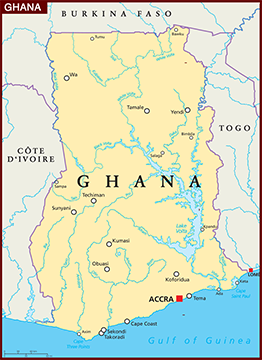Pharmacoeconomic Guidelines: Ghana
Country/Region: Ghana

PE Guidelines
PE Guidelines Source:
HTA Secretariat, Pharmacy Directorate, Technical Coordination Directorate, Ministry of Health, P. O. Box MB 44, Accra, Ghana.
Additional Information:
This is a set of recommended methodological standards required to conduct an HTA in a Ghana. It lays out formally accepted methods and assumptions underpinning analyses, and frames the boundaries of HTAs such as the scope, time horizon, outcome measure(s) as well as resource use and costing.
Information current as of Wednesday, January 31, 2024
Key Features
| Key Features | |
|---|---|
| Type of Guidelines | PE Guidelines |
| Title and year of the document | Reference Case for Health Technology Assessment (HTA) in Ghana. 1st Edition 2023. |
| Affiliation of authors | Ministry of Health (MOH), Ghana. |
| Purpose of the document | To provide standard guideline for the planning, conduct and reporting of HTA and economic evaluations in a given jurisdiction. It provides formally accepted methods and assumptions underpinning analysis, and frames the boundaries of HTA such as the scope, time horizon, outcome measures as well as resource use and costing. |
| Standard reporting format included | Not included yet. |
| Disclosure | Not clearly stated. |
| Target audience of funding/ author's interests | The MOH in collaboration with developing partners. |
| Perspective | The preferred perspective is societal. However, the perspective could be that of the government (which may include public funding health systems or the National Health Insurance Authority). In particular, all relevant effects based on chosen perspectives need to be reported. |
| Indication | Not clearly specified. |
| Target population | This must be specified. |
| Subgroup analysis | Yes. |
| Choice of comparator | This must reflect the decision problem and should include a comparison with standard practice or the status quo. The absence of a comparator must be justified. |
| Time horizon | This should be enough to capture any meaningful differences in the future costs and consequences likely to accrue or be associated with the competing technologies. A life time horizon is recommended for all analyses. Absence must be justified. |
| Assumptions required | Yes, but must be justified. |
| Preferred analytical technique | The preferred evaluation type is a cost-utility analysis (CUA), with the outcomes expressed in terms of Quality Adjusted Life Years (QALYs) gained or Disability Adjusted Life Years (DALYs) averted. Other economic evaluations are acceptable but must be justified. |
| Costs to be included | All costs are to be recorded including the source, effective period, and time of access. |
| Source of costs | Should include the public-funded health system or the National Health Insurance Authority. Other sources may be used but this must be justified |
| Modeling | Yes. |
| Systematic review of evidences | Yes, including those with meta-analysis. |
| Preference for effectiveness over efficacy | Yes. Effectiveness of the intervention is stated. |
| Preferred outcome measure | QALYs gained or DALYs averted. Any alternative measure must be justified. Alternative measures may be converted to QALYs or DALYs. |
| Preferred method to derive utility | Non-preference and preference-based methods. |
| Equity issues stated | Yes. |
| Discounting costs | Yes. The rate from Ministry of Finance (Ghana) is preferred, but where that is not available 3% is preferred. Sensitivity analysis between 1% to 10% is required for impact of discount rate. |
| Discounting outcomes | Yes. The rate from Ministry of Finance (Ghana) is preferred, but where that is not available 3% is preferred. Sensitivity analysis between 1% to 10% is required for impact of discount rate. |
| Sensitivity analysis-parameters and range | Sensitivity analyses are performed and respective ranges are chosen to check for robustness of results. |
| Sensitivity analysis-methods | This can be done using scenario analysis for different disease progression paths. Both univariate and multivariate sensitivity analyses are performed (deterministic). Multivariate sensitivity analyses can be performed as probabilistic sensitivity analyses. |
| Presenting results | Present numeric figures and plot graphs/scatter plots where applicable. |
| Incremental analysis | Yes. |
| Total costs vs effectiveness (cost/effectiveness ratio) | ICER and BIA depending on the situation. |
| Portability of results (Generalizability) | Yes, nationwide. |
| Financial impact analysis | Yes, BIA is recommended. |
| Mandatory or recommended or voluntary | Not clearly stated. We are in the early stages of our HTA. |
Acknowledgement:
| Hon. Kwaku Agyeman-Manu, Joycelyn Azeez, Brian Asare |